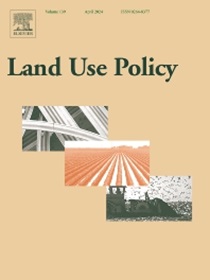Traceability and projected patterns of Africa’s land use systems and climate variability (1993–2053)
IF 5.9
1区 社会学
Q1 ENVIRONMENTAL STUDIES
引用次数: 0
Abstract
This study investigates the causality between land use and land cover change (LULCC), and variations in temperature and precipitation across Africa. To do this, we employ integrated remote sensing techniques, causal analyses, and representative studies. We further utilize Modules for Land Use Change Evaluation (MOLUSCE) and Random Forest (RF) to simulate land use scenarios from 2033 to 2053. The findings reveal a complex interplay of socio-political, economic, and biophysical factors driving LULCC from 1993 to 2023. During this period, northern and western Africa experienced forest regrowth (+2.61 %), while deserts (-12.29 %), grassland/shrubs (-14.20 %), and farmlands (-14.53 %) decreased. In contrast, built-up areas expanded by + 134.63 %, and water bodies increased by + 71.63 %. The predicted trends indicate continued reductions in deserts and bare land, with annual decreases of 0.59 % and a decline of 0.48 % for grasslands/shrubs over the next 30 years. The current study achieved a 96 % accuracy rate based on the samples used throughout the study duration. Rising temperatures in northern Africa are associated with increased desertification, while dense forests and water bodies in central and southern Africa help mitigate heat. K-means clustering identifies distinct regional patterns in the impacts of LULCC, stressing the need for targeted interventions. The insights generated will be valuable for regions with limited resources and institutional capacity to address environmental challenges associated with these undesired changes. Ultimately, these findings can foster stronger collaboration within Africa’s economic blocs, supporting regional efforts toward sustainable development, effective land management, and climate adaptation.
非洲土地利用系统与气候变率的可追溯性和预估模式(1993-2053)
本研究调查了非洲土地利用和土地覆盖变化(LULCC)与温度和降水变化之间的因果关系。为此,我们采用了综合遥感技术、因果分析和代表性研究。我们进一步利用土地利用变化评估模块(MOLUSCE)和随机森林(RF)模拟2033 - 2053年的土地利用情景。研究结果揭示了社会政治、经济和生物物理因素在1993年至2023年间驱动LULCC的复杂相互作用。在此期间,非洲北部和西部经历了森林再生(+2.61 %),而沙漠(-12.29 %)、草地/灌木(-14.20 %)和农田(-14.53 %)减少。建成区面积增加了+ 134.63 %,水体增加了+ 71.63 %。预测趋势表明,未来30年,荒漠和裸地面积将继续减少,草地/灌木面积年减少0.59 %,年减少0.48 %。基于整个研究期间使用的样本,目前的研究达到了96% %的准确率。北非的气温上升与沙漠化加剧有关,而非洲中部和南部的茂密森林和水体则有助于缓解高温。K-means聚类识别出LULCC影响的不同区域模式,强调需要有针对性的干预措施。对于资源和机构能力有限的地区来说,由此产生的见解对于解决与这些不希望发生的变化相关的环境挑战将是有价值的。最终,这些发现可以促进非洲经济集团内部更强有力的合作,支持实现可持续发展、有效土地管理和气候适应的区域努力。
本文章由计算机程序翻译,如有差异,请以英文原文为准。
求助全文
约1分钟内获得全文
求助全文
来源期刊

Land Use Policy
ENVIRONMENTAL STUDIES-
CiteScore
13.70
自引率
8.50%
发文量
553
期刊介绍:
Land Use Policy is an international and interdisciplinary journal concerned with the social, economic, political, legal, physical and planning aspects of urban and rural land use.
Land Use Policy examines issues in geography, agriculture, forestry, irrigation, environmental conservation, housing, urban development and transport in both developed and developing countries through major refereed articles and shorter viewpoint pieces.
 求助内容:
求助内容: 应助结果提醒方式:
应助结果提醒方式:


